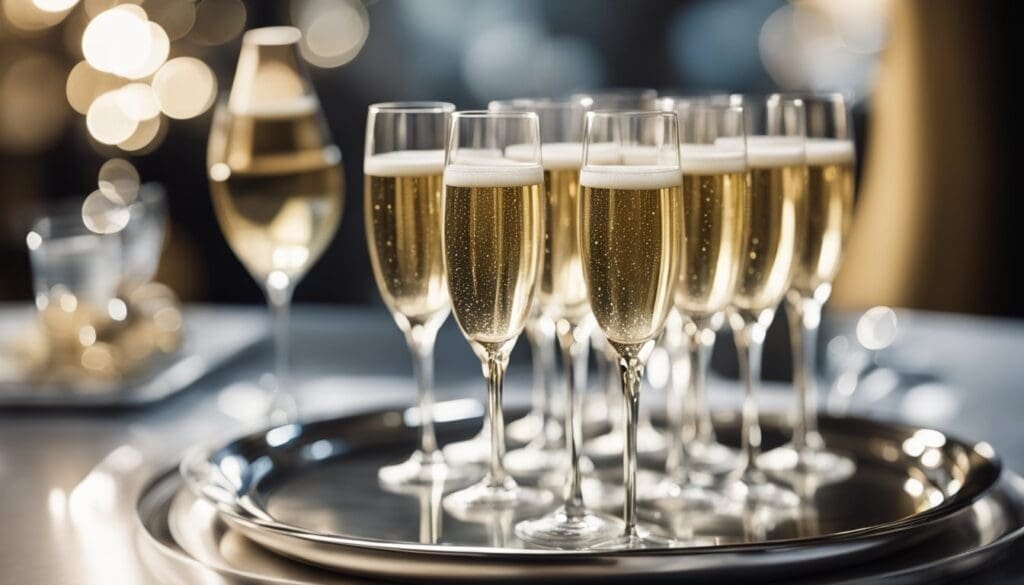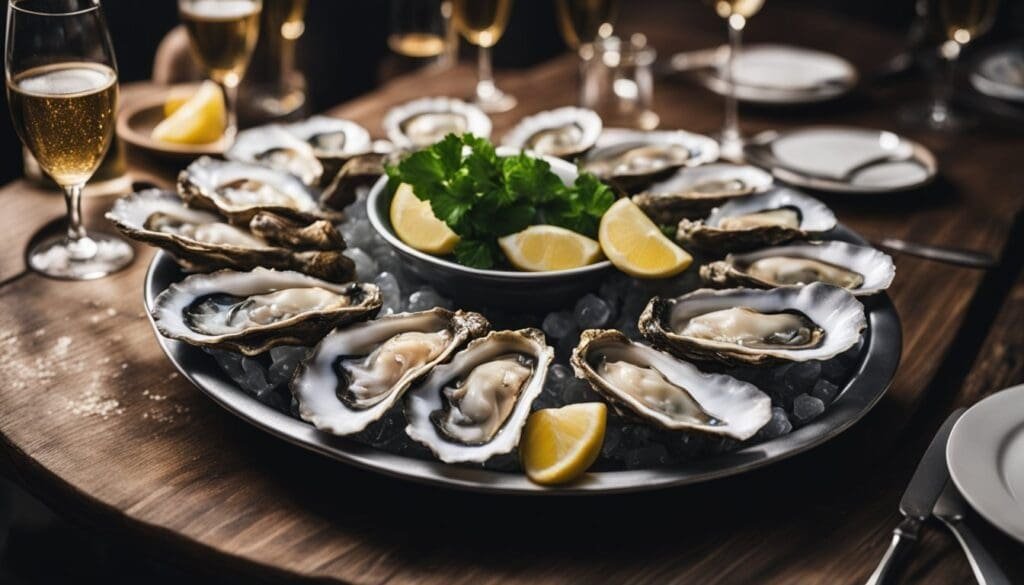Does all champagne taste the same? Have you ever thought if every champagne bottle tastes differently? Or, perhaps they offer a special flavour each time?
Champagne is that special drink for big moments like New Year’s and weddings. It comes only from the Champagne region in France. Also, it must be made with grapes from there, and follow a specific way of making. These rules make champagne different from other sparkling wines.
Champagne gets its special taste from the main types of grapes used. These are Pinot Noir, Pinot Meunier, and Chardonnay. Each grape adds its own special flavour, like making it complex, bright, or elegant. The way champagne is made, called “Methode Champenoise,” makes it bubbly and high-quality. When you open a champagne bottle, it should softly hiss, not loudly pop.
What Makes Champagne Unique?
Understanding champagne means knowing what makes it different to other sparkling wines. Its unique elements include the region it’s from, the grapes used, and how it’s made. These things give champagne its special taste.
The Champagne Region
The Champagne region in France is key to this special drink. It has a unique kind of soil and a cold climate. This area’s name is protected, so only wines made here can be called champagne.
Champagne Grapes
Champagne’s taste comes from the special grapes used. The main types are Pinot Noir, Pinot Meunier, and Chardonnay. These grapes add different tastes. Together, they make champagne’s unique flavours come alive.
The Traditional Method of Production (Méthode Champenoise)
Making champagne uses a special process called Méthode Champenoise. A second fermentation in the bottle makes its bubbles. Steps like riddling and disgorgement help make champagne sparkle. This method shows the care and skill that goes into every bottle of champagne.
Different Styles of Champagne
When you try different types of Champagne, you discover a range of delicious flavours. Each kind has its own unique taste. This comes from the kinds of grapes used and how it’s made.
Brut
Brut is very popular and seen as the standard in Champagne. It’s a dry type made from Pinot Noir, Pinot Meunier, and Chardonnay. This mix lets you taste zesty citrus to light yeast.
Rosé
Rosé Champagne has a lovely light pink colour. It gets this look by being in touch with red grape skins a little or by mixing red and white wines. You might taste red berries in it, which makes it unique.

Blanc de Noirs
Blanc de Noirs uses only dark grapes like Pinot Noir. Even though it’s made from red grapes, it’s still a light wine. It has big flavours like berries, plum, and sometimes even savoury tastes.
Blanc de Blancs
Blanc de Blancs comes only from Chardonnay grapes. It’s known for being light and tasting of flowers and citrus. This Champagne can also get better with time, gaining more complex flavours. It’s perfect for special times or to keep in your collection.
The Role of Sweetness Levels in Champagne
It’s key to know about sweetness in champagne to truly enjoy its different tastes. Sugar added after removing the yeast helps make the final flavour. Sweetness levels are marked to fit everyone’s taste.

Brut Nature and Extra Brut
Brut nature has no extra sugar, so it’s very dry and lets you taste the pure fruit. Extra brut is also dry but lets a hint of the grape’s taste through, for those who like it less sweet.
Brut and Extra Dry
Even though their names suggest otherwise, brut and extra dry types have a bit of sweetness. Brut is very popular and combines dryness with a hint of fruit’s flavour. Extra dry has more sugar than brut. This adds a bit more sweetness while keeping the champagne taste.
Sec, Demi-sec, and Doux
Now we’re talking sweet, with sec, demi-sec, and doux champagnes. Sec means ‘dry’ but they are quite sweet. Demi-sec is sweeter, good for those who love sweet drinks, and doux is the sweetest. People often enjoy it with dessert. These types make sure there’s a champagne for every sweetness level.
Does All Champagne Taste the Same?
You might wonder if all champagnes taste alike. The clear answer is no. Each champagne offers a different flavour range, making your tasting journey unique.
The taste of a champagne depends on many things. One big factor is the mix of grapes used. The main ones are Pinot Noir, Pinot Meunier, and Chardonnay. They add their own special touch. Pinot Noir gives it body, Pinot Meunier makes it fruity and fresh, and Chardonnay adds elegance.
Then, there’s the ‘dosage’, a little sugar added before sealing the bottle. This sugar changes its sweetness level. So, some champagnes might be very dry, like Brut Nature, while others are sweet, like Doux. This means champagnes come in various sweet tastes, making each one a new treat.
The way champagne is made also affects its taste. The Méthode Champenoise is a special way to make it. It includes a second fermentation in the bottle and steps like turning the bottles and removing the yeast. This method makes the bubbles fine and the flavours rich and deep, setting every bottle apart.

Then, there’s the difference between vintage and non-vintage champagnes. Vintage champagnes come from a single great year. They often have a more powerful, refined taste. Non-vintage champagnes mix grapes from different years. This aims to make their taste steady and reliable every time you enjoy one.
So, not all champagnes taste alike. It’s the mix of grapes, sugar level, how it’s made, and if it’s vintage or not that create distinct flavours. Exploring these differences shows you the rich variety in every glass of champagne.
Factors Influencing Champagne Flavour
It’s key to know what affects champagne’s taste. This includes the grape types used and how it’s aged. Each part of the process adds something special to the drink we love.
Grape Blend
Champagne taste depends a lot on the grapes mixed in. Chardonnay makes it light and classy. Pinot Noir gives it a full body. Pinot Meunier adds a soft, fruity touch. Mixing these grapes makes each champagne taste stand out.
Lees Aging
Aging on yeast, called lees, boosts flavour and depth. This process can last a few years. It gives champagne its smoothness and rich smell. So, how long it ages on lees changes the final taste.
Dosage and Sweetness Adjustment
After certain steps, a mix of wine and sugar is added. This is the dosage. It changes the sweetness and taste. From dry Brut Nature to sweet Demi-Sec, dosage is key to the flavour.
Vintage vs. Non-Vintage Characteristics
Vintage and non-vintage champagnes taste different. Vintage comes from one special year’s grapes. Non-vintage mixes grapes from several years to keep a familiar taste. Picking between them adds fun to tasting champagnes.
Common Champagne Tasting Notes
Champagne tasting is like exploring a rich tapestry. It’s full of flavours and scents that show its special qualities. Every taste has elements that mix into a unique experience.
Fruit Flavours
Champagne is full of fruity tastes. You might find zesty citrus or fresh green apple. All these flavours come from the grapes used, like Pinot Noir and Chardonnay. Such tastes give each champagne its special twist, including hints of red fruits in Rosé kinds.
Secondary Characteristics
Champagne doesn’t stop at fruits. It gets more complex with toasty almond or warm bread notes. These flavours come from yeast touching the champagne as it ages. They bring a deeper, richer taste to your glass.
Organic and Mineral Flavours
Great champagnes also have earthy and mineral tastes. These add a layer to the bright fruity ones. You might notice creamy textures, marzipan hints, and a bit of chalk. These touches reveal the special Champagne area’s character. So, each sip feels unique and wonderful.
Conclusion
Champagne comes in many flavours, thanks to where it’s made and how. There’s a lot to consider, like where the grapes grow, how they’re mixed, and who makes them. Each champagne tells a special story with its taste.
Some champagnes are crisp and light, like Blanc de Blancs. Others are deep and full, like Blanc de Noirs. You can also choose between drier types (Brut) or sweeter ones (Demi-sec). There’s a champagne for every taste and occasion. Your pick can make your celebration even more special.
Learning about champagne can make you enjoy it even more. From the land the grapes grow on to the careful making process, every step adds to the taste. This makes exploring champagne’s flavours a fun adventure. It’s something anyone, from wine lovers to occasional drinkers, can dive into.
Frequently Asked Questions
What makes champagne unique?
Champagne is special because it comes from the Champagne region in France. It uses certain grapes – like Pinot Noir, Pinot Meunier, and Chardonnay. Plus, it goes through a careful process called the Méthode Champenoise. This creates its notable bubbles and rich tastes.
What are the different styles of champagne?
There are many types of champagne, including Brut, Rosé, Blanc de Noir, and Blanc de Blancs. Brut is dry and not from a specific year. Rosé has a pink colour. Blanc de Noir comes from red grapes. Blanc de Blancs is only Chardonnay.
What role does sweetness play in champagne?
The sweetness in champagne is decided by the dosage added after the bottle neck is frozen and the sediment removed. Champagnes go from very dry (Brut Nature) to very sweet (Doux). Others like Extra Brut, Brut, Extra Dry, Sec, and Demi-sec fall in between.
Does all champagne taste the same?
Not all champagne is alike. The mix of grapes, sweetness, how it’s made, and if it’s from a single year or not make each one’s flavour unique.
What factors influence champagne flavour?
Champagne taste is affected by the grape mix – usually Pinot Noir, Pinot Meunier, and Chardonnay. Also, the way it ages on the lees, the dosage, and if it’s vintage or not all play a part.
What are common tasting notes for champagne?
Champagne often tastes of fruits like citrus and green fruits. You might also notice almond, toast, and earthy notes. These can be creamy or have a bit of marzipan sweetness.
User Review
( votes)Sip smarter, subscribe now!
Subscribe for gourmet tips, event updates, travel ideas, and a free e-book on Food Pairings. Start your journey to culinary and travel excellence!













